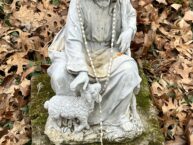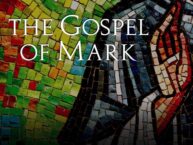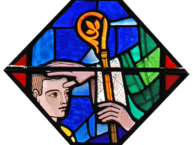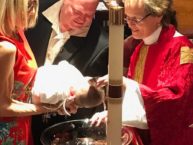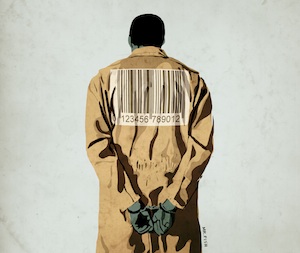 May God’s words alone be spoken, may God’s words alone be heard. Amen.
May God’s words alone be spoken, may God’s words alone be heard. Amen.
So, today is Trinity Sunday. Now, folks like to answer, when asked about this doctrine – “It’s a mystery.” Others would respond the same way when asked why on earth there is a Trinity Sunday, given that it is the only Sunday given over to a doctrine, rather than a scriptural event or in celebration of our lives in Christ. But nevertheless, here we are.
Now on Facebook I saw the following posted from a bit The Onion, a satirical online newspaper put out a few years back, with the headline “God Quietly Phasing Holy Ghost Out Of Trinity” It read: Calling the Holy Trinity “overstaffed and over budget,” God announced plans Monday to downsize the group by slowly phasing out the Holy Ghost. “Given the poor economic climate and the unclear nature of the Holy Ghost’s duties, I felt this was a sensible and necessary decision,” God said. “The Holy Ghost will be given fewer and fewer responsibilities until [Her] formal resignation from Trinity duty following Easter services [next year]. Thereafter, the Father and the Son shall be referred to as the Holy Duo.” I should think that would be the Dynamic Duo – oh wait…Batman and Robin have that title.
Actually, it seems that the Holy Spirit always seems to be the least understood part of that Trinity. Given that we are in the season of Pentecost, perhaps we need to think about that a bit more. Or, maybe it is just that for many years, based on the King James translation of the bible, many called it the Holy Ghost, which led to a boatload of fun misinterpretations, mostly by children.
There was one story, where a family from India traveling around California on business, left their 11 year-old daughter with some friends who had kids about the same age. Curious about going to church one Sunday morning, she decided to come along with her host family. When they returned home, the host parents asked her what she thought of the service. “I don’t understand why the West Coast isn’t included too,” she replied. When they asked her what she meant, she added, “You know, in the name of the Father, the Son, and the whole East Coast.”
Or another story of two kids playing in the puddles around their house when their mom noticed the older boy pushing the younger one’s face into one of them. They were both laughing afterward, but the mom ran outside and said “Michael, what were you doing pushing Billy’s face into that puddle!” But, Billy said, “It’s okay Mom, were were just playing church.” “Yeah,” Michael added, “I was bath-tizing him in the name of the Father, and the Son, and in the hole he goes!”
Kids… but truthfully, I think most of us adults don’t get the whole idea of this Trinity thing or how or what is the Holy Spirit any much better than they do. At our Theology on Tap this week, we talked about the concept of the Spirit – how it crosses faiths, what is the Spirit, how does the Spirit work, and more. It was a big group and terrific conversation about that part of the Trinity that seems to unite all faiths and even those who claim a Spiritual, but not religious identity.
Maybe that is why Christians tend to focus on Jesus. They can wrap their heads around this fully human, incarnational, aspect of God, but God and the Spirit, now that takes some work. And lump them all together into some three in one, one in three thing not only sounds like bad math, but like some sort of unsolvable puzzle that makes you want to pull your hair out.
Even great theologians are not immune. There is a story about one of Christianity’s most famous theologians and bishops, Augustine, and as the legend goes, there was a small pool, a little boy with a seashell, and a sandy beach on which St. Augustine, clad in his episcopal robes, is walking, pondering with difficulty the mystery of the Most Holy Trinity. “Father, Son, Holy Spirit; three in one!” he muttered, shaking his head. As he approached the little boy who was running back and forth between the sea and the pool with a seashell of water, Augustine craned his neck and asked him: “Son, what are you doing?” “Can’t you see?” said the boy. “I’m emptying the sea into this pool!” “Son, you can’t do that!” Augustine countered. But the boy said “I will sooner empty the sea into this pool than you will manage to get the mystery of the Most Holy Trinity into your head!” Upon saying that, the boy, who was an angel according to legend, quickly disappeared, leaving Augustine alone with the mystery of the Most Holy Trinity.”
So, we are not alone with this wrestling of how to understand God as expressed in this Trinitarian formula we call the Holy Trinity.
But maybe we are missing the point.
When I was out mowing the lawn yesterday, tired from reading all the commentary and not sure how to frame this sermon, I realized that I was really enjoying the journey itself. I was blown away by how sometimes wrestling with the text, or in this case – doctrine, can expand my faith, my understanding of God, and my relationship with God, in so many unexpected ways. I realized that it is the quest for understanding that is in itself the answer. The Trinity is a way of understanding God that in itself works like what is known as “a koan in Zen Buddhism.
A Zen master will frequently give a novice a koan — a paradoxical story or question — on which to meditate. Perhaps the most famous koan is: “What is the sound of one hand clapping?” There’s no answer to the question. As many times as the novice may return with an answer, the master will say, “No, that’s not it” and send the student back to meditating again. The novice must learn, somehow, to live with the question without understanding it. Kathleen Norris writes of an Eastern Orthodox contemplative who gave his disciple a piece of dry wood with the instruction: “Water it until it bears fruit.” The task is impossible to understand — and in that respect, it’s rather like the Trinity.”
And while I found a lot of joy in thinking about that, there is something more here that must be talked about. You see, while the Trinity can help us try to understand something about God, for which no concept, doctrine, or definition can ever be fully adequate, the very idea of it is powerful beyond our imaginations, because it is speaking to a fundamental understanding of our place in this cosmic creation, of God’s desire for us, and most especially – who we are.
The Trinity, speaks as much about us as it does about God.
Let me say that again, the Trinity speaks as much about us as it does about God.
Or perhaps more to the point, whenever we try to understand God, we are really in a search for understanding about who we are, and what our lives are all about. And the Trinity is an amazingly beautiful and powerful image for that. Because the Trinity is a relational model. It’s all about relationship!
And in those three in one/one and three, it was the incarnation, Jesus, that makes us consider God in a new way. The incarnation showed the human side of God’s nature – so we could know more about us, the one’s made in God’s image, and also about God, and God’s desire to be in relationship with us.
And this divine nature of God in humanity was the very message that Jesus was trying to teach us. In Jesus’ life, death and resurrection, we came to know a God who wanted to be in deep and abiding relationship with us, but just as much, we came to understand our role in the Trinity, as the fully human children of God. That is a powerful thing!
If we understand what Jesus taught us, then we understand that we are a part of the relational identity of God – all of humanity is. We are all children of God, created in God’s image. In a very real sense, walking breathing trinities. So, in relationship with God, yes, and also with all of creation, just as God is in relationship with all of creation. Because Jesus taught us something incredibly important about who we are and what we are called to do – something we seem to forget far too often. In his life, Jesus sought out those who were pushed aside, taught us that we are to love the poor, made it clear that when we care for the sick, feed the hungry, or visit the imprisoned, we are caring, feeding, and visiting him – Jesus, that part of the relational Trinity.
Now, let that soak in for a moment…
Because what he was saying is that within all those people, he exists, God is present in her children (well, that makes sense right – there is always a part of the parent in every child, right?)
Perhaps it would be helpful if we changed the mental image we have about the Trinity to really get at what Jesus was trying to teach us. Forget clover leafs, eggs, or even the image on our bulletins this morning, and let’s try a new Trinity – a Trinity that is as much God as any we have envisioned before:
Let’s try a Trinity like this: God the gay white woman, Christ the young black man, the Holy Spirit the undocumented Hispanic child. Or God the Russian, Christ the South Korean, and the Holy Spirit the African. Or God the Jew, Christ the Buddhist, and the Holy Spirit the Muslim. Or God the refugee, Christ the prisoner, and the Holy Spirit the disabled. Or…well, you get the picture.
Those Trinity images are as much God as any other.
So what does that mean for us?
It means that when we marginalize or neglect or refuse to see any part of God’s creation, any part of humanity, we do that to God. If we understand God as in relationship with humanity – that means ALL of humanity – us, the poor, the undocumented, the rich, the nice, the not-so-nice, the old, the gay, the disabled, the female, the male, the ones of color, the imprisoned, the lonely, sick, marginalized. God is in all of them. And right now, in this country, we are putting God in jails in record numbers.
Here are just a few statistics that should be a wake up call to all of us:
- We imprison more people than any other country
- The U.S. has over 2.4 million behind bars, an increase of over 500% in the past thirty years
- We have 5% of the world’s population; 25% of its prisoners
- People of color represents 60% of people in cages
- One in eight black men in their twenties are locked up on any given day
- 75% of people in state prison for drug conviction are people of color although blacks and whites see and use drugs at roughly the same rate. In NYS alone, 94% of those imprisoned for a drug offense are people of color.
- The number of drug offenders in state prison has increased thirteen-fold since 1980
- 3 million Americans are denied their right to vote
- 13% of black men are disenfranchised
- Over the past two decades, state spending on prisons grew six times the spending of higher education
- From 1997 to 2007 the number of women in prison has increased by 832%
- Nearly $70 billion is spent annually on prisons, probation, parole and detention[1]
Michelle Alexander writes in The New Jim Crow that: “The United States now has the highest rate of incarceration in the world, dwarfing the rates of nearly every developed country, even surpassing those in highly repressive regimes like Russia, China, and Iran…This high rate of incarceration has a few simple causes. We have a tremendous investment in the War on Drugs that is a pipeline to prison for some. And we have a thriving prison industry. There are huge profits to be made from this system. When the true bottom line is money-making, the value of human rights are just not as important. Human beings become expendable. Whole lives are tossed aside in pursuit of the almighty dollar. As cynical as this sounds, the evidence is commanding of our attention.”
Anyone who has ever worked in the corporate world can attest to what she is saying. Businesses value shareholders and profit over those employees who produce the goods. In a choice between caring for them or increasing profits, time and again businesses opt to increase profits on the backs of the laborers, without regard for their welfare. So none of us should be surprised that when profit is to be made running prisons, there is a greater interest in ensuring they are filled, and keeping expenses down – including the cost of care for those behind bars.
The incarnation is incarcerated – and profits are being made on the backs of the ones Jesus said were him.
As the website JusticeNotJails put so well, “Christians know that it is not given to us to avert our eyes from the places of pain and suffering. Scripture records that at the start of his ministry, Jesus looks upon the masses of poor people in his society who were suffering horribly and, “moved by compassion,” he begins to heal and restore these same people. The story of incarnation is not simply that God enters human life as one who suffers like us, but God enters specifically to minister to those who suffer most. None of us can doubt that mass incarceration in 21st century America inflicts tremendous suffering upon those incarcerated and also upon their family members and friends. This is the place of pain that is calling to us to be God’s agents in a ministry of solidarity… Christians can also never forget that Jesus himself was unjustly condemned–“framed,” we might say–and sentenced to an ignominious death by corrupt Roman authority. In our own setting we must never, ever assume that people are only locked up because they “deserve it” or because they “have it coming.””[2]
The incarnation is incarcerated – and we must respond out of our Trinitarian nature.
The truth of the doctrine of the Trinity is that it isn’t about getting God right, but about getting ourselves right. It is about us as much, or more, than about God. It really is a koan upon which we might visualize the fullness of God, ourselves, and all of creation, and what that means for us and for the world. And in that journey of discovery, we come to realize our relationship with God, and with one another – not just those next to us in the pews, but everyone. And we have left behind so many, perhaps some of you or people you know.
But there is hope for us, and for them, because as we come to understand our lives, we become empowered by the Spirit – the same Spirit Jesus spoke about in the Gospel – the same Spirit here through all creation, whom we celebrate in this season of Pentecost – we become empowered by her to do something about it.
The task can sometimes seem as impossible as what that boy on the beach was trying to do with his little seashell carrying the water from sea to pool, but we never ever do it alone. Like the relational model the Trinity offers us – God is in relationship with us. And God is calling each of us to live fully into our Trinitarian relationship here on Earth. The incarnation is incarcerated, and we need to be the body of Christ – responding to those in need and fighting against injustice.
We are a people of God, called to love and to serve.
Called and empowered to change the world.
Let’s get going!
Amen.
[The focus on Mass Incarceration was part of a District 5&7 effort for all clergy to preach about this injustice on this Sunday.]
For the audio from the 10:30am service, click here:
[1] Retrieved from The Center for Law and Justice: http://www.cflj.org/new-jim-crow/new-jim-crow-fact-sheet/
[2] http://justicenotjails.org/christians-and-mass-incarceration/
The Rev. Diana L. Wilcox
Christ Church in Bloomfield & Glen Ridge
May 22, 2016
Trinity Sunday – Year C
1st Reading – Proverbs 8:1-4, 22-31
Psalm 8
2nd Reading – Romans 5:1-5
Gospel – John 16:12-15

